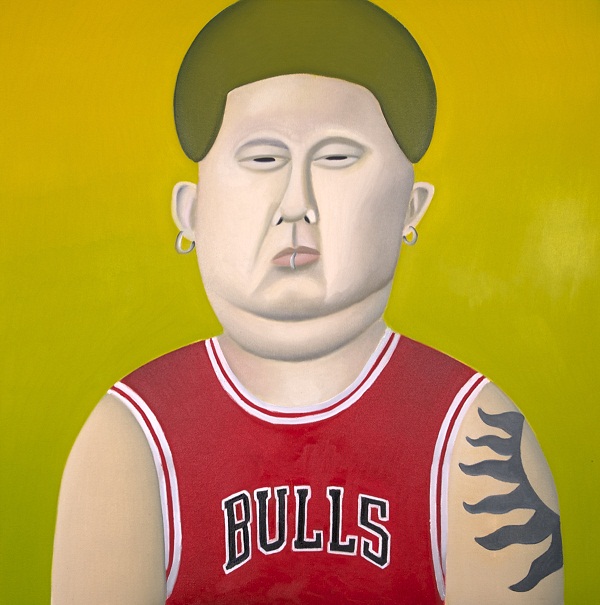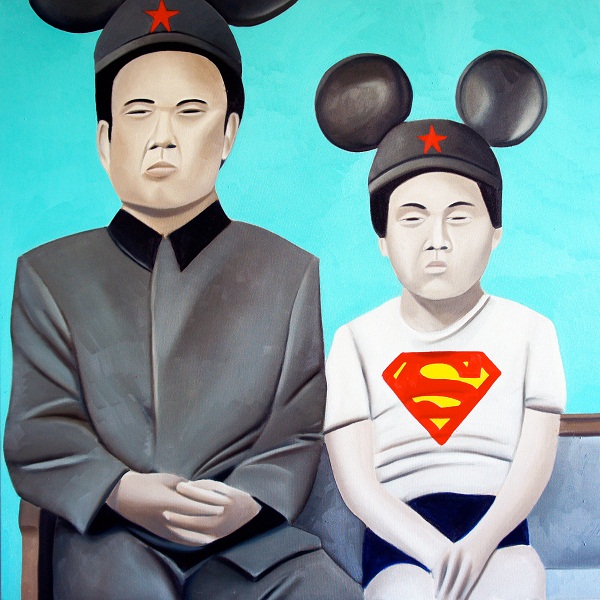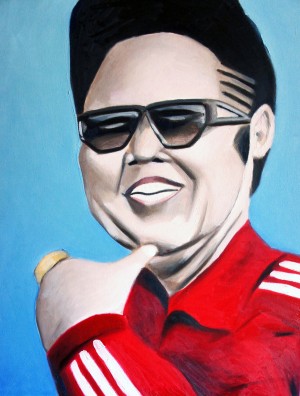Artist of the Week 8/22 – 8/28: Pete Kirill Merges the Line between Communism and Capitalism
GALO: Jong-il is usually depicted as a serious, cold man, but you depict him as being joyful, full of life and having fun? Is this purposeful irony or did you learn something about the dictator that was reason enough for the unusual depiction?
PK: Yes, Kim Jong-il is depicted as a serious, cold man, but only in Western and capitalist media. In North Korea, the “Dear Leader” is portrayed as a loving, divine-like father figure, who is always smiling on his people. This mystical depiction of Kim Jong-il seems based in part on the personality cult that surrounds him, which was inherited from his father Kim Il-sung. Many North Koreans believed that he had the “magical” ability to change the weather based on his mood. It is this fabricated God-like depiction of the communist dictator that fascinates me, and which I explore in this series. The Kim Jong-il that is referenced in my work can be seen as mocking him by some, but may also be seen as celebrating the “Dear Leader” by those in his country who idolize him.
GALO: You applied a light-hearted approach to a series that in essence exposes the long and tumultuous relationship between capitalism and communism. What challenges did you face in keeping these elements balanced?
PK: The biggest challenge for me is finding an image from North Korea that resonates with me enough to make it the subject of a painting. It is usually something I find strange or weird in the image. The next challenge is choosing the one or two capitalistic elements to add to it. Although these elements are sometimes very small in scale, compared to the size of the painting, they are big and bold in color and have symbolic meaning. I think this creates a nice balance between color, composition, and semantics.
GALO: The past North Korean dictator is painted as having a very Western demeanor. What was the purpose of depicting Kim Jong-il in a variety of pop-culture and “American” situations?
PK: The settings and situations that I refer to in my paintings are North Korean, but I have given them a Western feel. Although they are images that appear to have been taken by the North Korean state media for propaganda purposes, the pose or gesture often seems to resemble that of a Hollywood actor or celebrity. And although any aspect of Western culture is forbidden to the citizens of North Korea, their leaders secretly indulge in the extravagance that Western society and culture provides.
The North Korean leaders, and particularly Kim Jong-il, when he was alive, enjoy many of the luxuries that the West has to offer, similar to celebrities in the Western world. And while many aspects of their lavish lifestyle are hidden from their citizens, they do present themselves to their public in much the same way that Hollywood stars do, with a “larger than life” presence in pictures of themselves. In North Korea, “Dear Leader,” Kim Jong-il and son, Kim Jong-un, are the only celebrities that North Korean citizens are allowed to idolize and worship.
By incorporating only one or two capitalistic elements into a Kim Jong-il or Kim Jong-un portrait, the piece is transformed to reflect American pop culture, illustrating the strong similarities between dictator worship and celebrity idolization that is apparent in both these two cultures. At the same time, the pieces also reveal the North Korean leaders’ own secret fascination and engagement with Western luxuries and American pop culture.

From Pete Kirill’s “A Dictator Visits Miami” series is a piece entitled “Kim Jong Rodman.” 40′ x 40′ oil on canvas. 2012. Photo Credit: Pete Kirill.
GALO: You were born in Mobile, Alabama. Where did you grow up and what would you say is your relationship to politics?
PK: I was born in Mobile, Alabama, but I did not grow up there. I spent most of my adolescent years living in New England in Darien, Connecticut, which is about 30 miles north of New York City. Growing up in a town so close to New York, one could not help but be influenced by the fashion and other cultural trends that came out of the city. This was also evident in the youth.
During my time in middle school in the late 1980s, the hip-hop movement emerged from New York. When I first heard this music, I saw the way the artists dressed and, as a young teen, I was mesmerized. Artists like Run DMC, Slick Rick and Big Daddy Kane, came onto the scene, sporting hi-top fades, Adidas track suits and big, flashy, gold chains. I was fascinated with this music and culture and idolized these artists. This influence and my fascination with hip-hop during the 1980s and early 1990s had a large impact on me during my years growing up, and is often referenced in this series.
Although I am interested in world politics and history, and follow international and domestic political trends closely, I would not consider myself a political person, nor do I have a relationship with any particular political ideology. I do, however, strongly support such principles as freedom of speech and expression, human equality, and the right to participate in choosing ones political leaders. And while many view my works as making a political statement, the intent is, rather, to trigger political thought on the part of the viewer, but is equally intended to draw parallels between diverse political ideologies.

“Portrait of Kim Jong-il and Kim Jong-Un,” 48″ x 48″ oil on canvas, 2011, by Pete Kirill. Photo Credit: Pete Kirill.
GALO: You decided to take on the personal life of the North Korean dictator, including portraying Kim Jong-il with his son Kim Jung-un in what seems to be a Mickey Mouse hat and a Superman shirt. You took a real portrait of Kim Jung-il, his son, his sister-in-law and her children, and transformed it into a depiction of an awkward father and son moment. Why did you choose this portrait and why did it resonate with you?
PK: When I first came across this photo I was overcome by the eerie feeling it gave me. Family portraits usually capture a happy and loving moment, but in this portrait no one is smiling. What fascinated me even more about this photo was the tension and unease I saw between Kim Jong-il and his son sitting next to each other.
Kim Jong-il’s head is slightly tilted in the opposite direction from his son, as if he is looking away from him. His son looks nervous and tense, with his hands crossed in-between his legs. The tension and nervousness may be the result of being the son of a powerful dictator.
My biological father was like a dictator at home and at his successful car businesses. The pressure he put on me to be like him and follow in his footsteps felt overwhelming and cruel at times, making me feel nervous and tense around him. The mood and feeling I saw between Kim Jong-il and his son reminded me of my own relationship with my biological father, and that became the focus of this painting.
(Article continued on next page)

